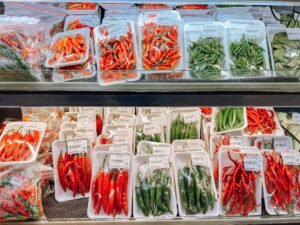How to Store Vegetable Shortening: Complete Guide for Long-Lasting Freshness
Vegetable shortening is a pantry staple in many homes, especially for baking enthusiasts. It is a type of fat made from vegetable oils, commonly used in recipes that require flaky pie crusts, tender cookies, and fried foods. Whether you use it daily or occasionally, knowing how to store vegetable shortening properly can significantly extend its shelf life and maintain its quality. Improper storage can lead to rancidity, loss of texture, and compromised flavor. This comprehensive guide will help you understand the best methods to store vegetable shortening and keep it fresh for as long as possible.
What is Vegetable Shortening and Why Proper Storage Matters
Vegetable shortening is a solid fat derived from hydrogenated vegetable oils such as soybean or palm oil. Its primary appeal lies in its high melting point and ability to create light, flaky, and tender textures in baked goods. Unlike butter or lard, vegetable shortening contains no water, making it ideal for recipes where you want to avoid moisture interfering with the final product.

Because shortening is primarily composed of fat, it is susceptible to oxidation when exposed to air, heat, and light. Oxidation leads to rancidity, which not only alters the flavor but can also make the product unsafe to consume. Storing vegetable shortening correctly helps preserve its freshness, flavor, and functionality, ensuring your baking results remain consistent and delicious.
How to Store Vegetable Shortening at Room Temperature
Storing vegetable shortening at room temperature is the most common method, as many shortening products are shelf-stable and do not require refrigeration. However, even at room temperature, some precautions are necessary to maintain its quality.
Always keep the container tightly sealed after each use. Exposure to air accelerates oxidation, which can cause shortening to develop an unpleasant odor or taste. Make sure the lid is securely closed to create an airtight environment inside the container.
Place the shortening container in a cool, dry, and dark place such as a pantry or kitchen cupboard. Direct sunlight, heat sources like ovens, and humidity can degrade the product quickly. The ideal storage temperature for vegetable shortening is between 50°F and 70°F (10°C to 21°C).

If your kitchen tends to get warm, especially during summer months, it is advisable to store the shortening in the coolest available cupboard, away from appliances like the stove or dishwasher that emit heat.
Can You Refrigerate Vegetable Shortening
Many people wonder whether refrigerating vegetable shortening is a good idea to extend its shelf life. The truth is, while shortening does not require refrigeration, keeping it in the fridge can help preserve it longer, especially in warm climates.
Refrigerated shortening tends to become firmer and may be slightly harder to measure or scoop directly from the container. However, this does not affect its performance once incorporated into recipes. If you opt to refrigerate vegetable shortening, always ensure the container is sealed tightly to prevent it from absorbing odors from other foods in the fridge.
Refrigeration can extend the usable life of shortening by several months, particularly if you live in a region with high temperatures or humidity levels that could otherwise accelerate spoilage.
Freezing Vegetable Shortening for Long-Term Storage
For those who use vegetable shortening infrequently or have purchased it in bulk, freezing is an excellent option for long-term storage. Properly frozen shortening can maintain its quality for up to two years or even longer, making it ideal for occasional bakers or people who stock up during sales.
To freeze vegetable shortening, divide it into smaller portions using airtight containers or heavy-duty freezer bags. Label the containers with the date so you can track how long it has been stored. When ready to use, allow the portion to come to room temperature before incorporating it into recipes.
Freezing does not affect the shortening’s structure or performance, and once thawed, it works just as well as fresh shortening in baked goods, frying, or other applications.
Signs That Vegetable Shortening Has Gone Bad
Even with the best storage practices, vegetable shortening does not last forever. It is important to know the signs of spoilage to avoid using rancid or expired product in your cooking.
The first and most noticeable sign of spoiled shortening is a change in smell. Fresh vegetable shortening has a neutral, almost odorless scent. If you detect a sour, metallic, or off-putting smell, it is a clear indicator that the shortening has gone rancid.
Another sign to watch for is a change in color or texture. Fresh shortening is usually white and smooth. If it appears yellowed, has developed spots, or shows signs of separation, it is no longer good to use.
Lastly, if the shortening imparts a strange taste to your food, discard it immediately. Using spoiled shortening not only affects the flavor but can also introduce harmful compounds into your recipes.
Shelf Life of Vegetable Shortening
The shelf life of vegetable shortening varies based on the storage method and whether the product has been opened. Unopened shortening, when stored in a cool, dark place, typically lasts up to two years from the manufacturing date. Always check the expiration or “best by” date printed on the container to ensure freshness.
Once opened, shortening remains usable for about one year if stored properly at room temperature. If refrigerated, it can last even longer, while freezing can preserve its quality for up to two years or more.
It is always good practice to inspect shortening for signs of spoilage before each use, especially if it has been stored for an extended period.
Best Containers for Storing Vegetable Shortening
Choosing the right container for storing vegetable shortening is essential to maintain its freshness. Most commercial shortening comes in resealable tubs or cans designed to protect the product from air and moisture.
If transferring shortening to another container, always use airtight, food-safe containers made from plastic, glass, or metal. Mason jars with tight-fitting lids, plastic storage containers with snap-on tops, or vacuum-sealed bags are excellent choices.
Avoid storing shortening in containers that are difficult to seal tightly, as exposure to air significantly shortens its shelf life.
Frequently Asked Questions About Storing Vegetable Shortening
How long does vegetable shortening last once opened
Once opened, vegetable shortening can last up to one year when stored properly at room temperature in a cool, dry, and dark place. If refrigerated, its shelf life can extend beyond one year, and freezing can preserve its quality for up to two years or more.
Can I use vegetable shortening past its expiration date
Using vegetable shortening past its expiration date is not recommended, especially if it shows signs of spoilage such as an off smell, discoloration, or strange taste. If the shortening still appears fresh and has been stored properly, it may be safe to use for a short period past the expiration date, but always inspect it thoroughly before use.
Is it safe to freeze vegetable shortening
Yes, it is completely safe to freeze vegetable shortening for long-term storage. Freezing does not affect its texture or performance, and it can extend the shelf life up to two years. Always store it in airtight containers or freezer bags to prevent freezer burn and odor absorption.
Does vegetable shortening need to be refrigerated after opening
Vegetable shortening does not require refrigeration after opening, as it is a shelf-stable product. However, refrigerating it can help extend its shelf life, especially in warm or humid climates. Keep the container tightly sealed to prevent odor absorption and maintain quality.

What happens if I use expired or rancid shortening
Using expired or rancid shortening can negatively affect the flavor and texture of your food. Rancid shortening has an unpleasant taste and odor, and while consuming small amounts is unlikely to cause serious harm, it is best to discard any spoiled product to ensure the quality and safety of your recipes.
Conclusion: Keep Your Vegetable Shortening Fresh with Proper Storage
Vegetable shortening is a versatile ingredient that enhances the texture and flavor of countless recipes. Proper storage is key to maintaining its freshness and functionality. By storing it in a cool, dry, and dark place, sealing the container tightly, and considering refrigeration or freezing for extended shelf life, you can ensure your vegetable shortening stays fresh and ready for use whenever needed.
Understanding how to store vegetable shortening not only protects your investment but also guarantees consistent, high-quality results in your baking and cooking projects. Whether you use shortening daily or occasionally, following these storage guidelines will help you enjoy its benefits to the fullest.
